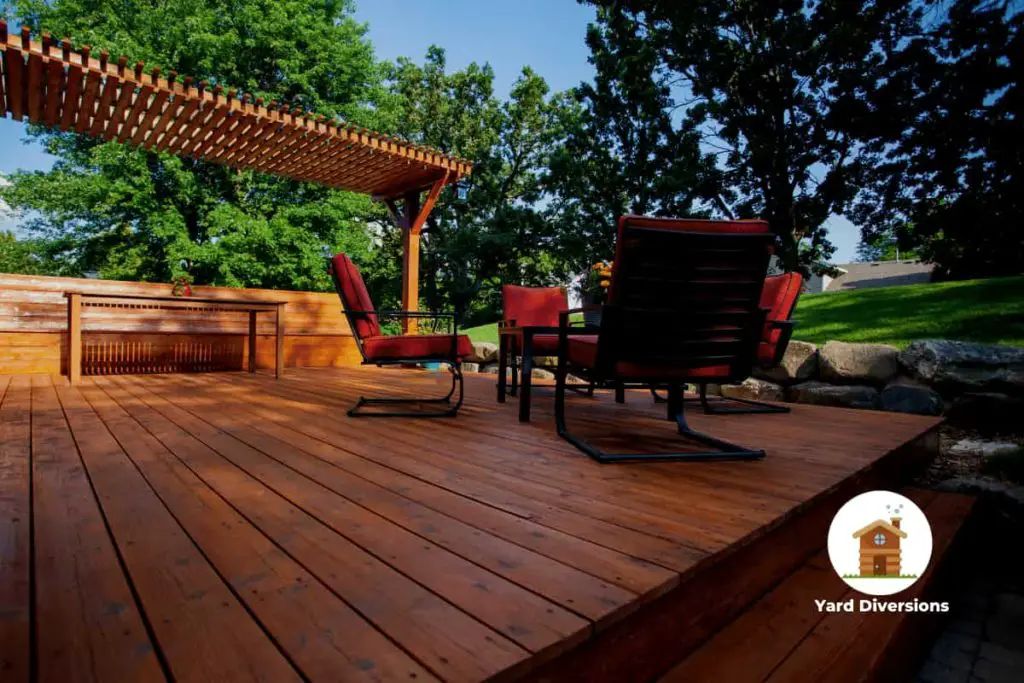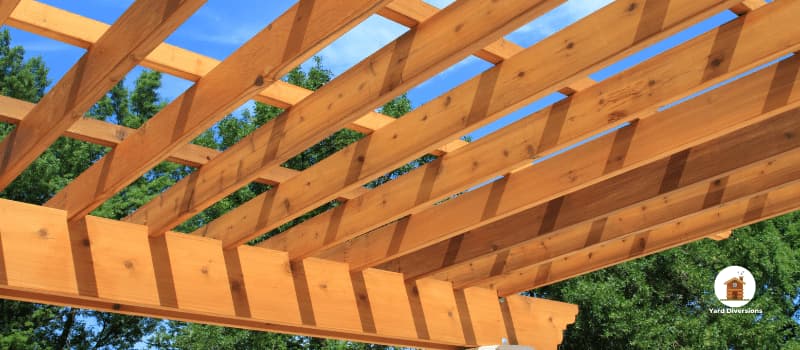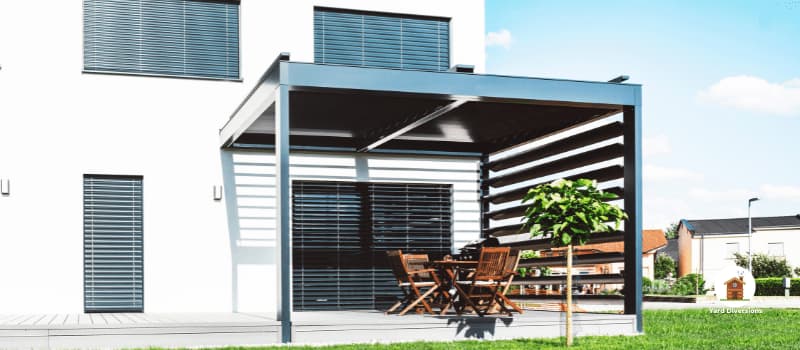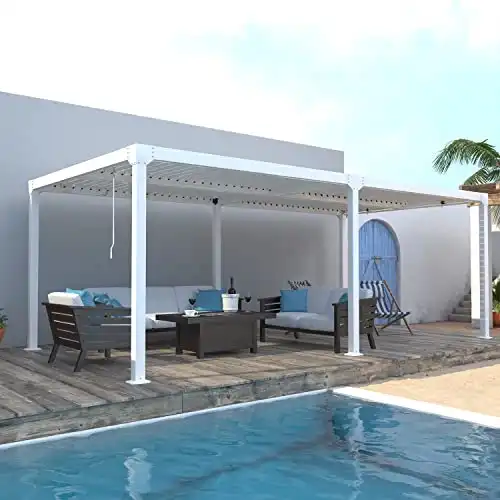A beautiful outdoor space is something that modern homeowners take very seriously. Many individuals often wonder what they may do to further accentuate the elegance of their backyard.
In their search for the ideal outdoor environment, most people at some point consider installing pergolas. However, installing a pergola is a big project, and there are a lot of things to think about.
In terms of material, you can choose between wood, vinyl, metal, or fiberglass as the base for your pergola. Then decide whether to have a self-supporting design or a wall-mounted design.
You will also need to consider whether to build it yourself or just install a prebuilt set. In this pergola buying guide, you will find all the information you need on pergolas.

Basics Of Modern Pergola Design
Pergolas are one of the most popular hardscape structures among new homeowners. It provides excellent outdoor space and gives the backyard or patio more character.
Not to mention it is the perfect space for crawling vines and flowers.
The modern or contemporary pergola designs often forego the greenery and opt for a more spartan look.
These pergola designs often match the overall exterior of the home and look like an extension of the living space.
Bear cross beams are fairly common these days as many people want to go for the “minimal” look. But the old renaissance and victorian styles are not entirely out of the picture.
Many people still prefer having some greenery on their pergola.
How Are Pergolas Different From Other Hardscape Structures?
There are quite a few garden structures that have almost similar functions as a pergola.
Learning about how they differ is a good way to decide whether you want a pergola or one of these other structures. You will also learn about what to look for while buying a pergola.
Pergolas are the closest to pavilions. The only difference between them is the roof structure. A pavilion will have a solid roof that offers full shade, while a pergola has a more open crossbeam structure.
Pergolas can have lattice roofs too. The key point is that it does not provide full shade so you will get a good deal of sunlight.
Most people confuse trellises and arbors with pergolas. Arbors are not for attaching to the side of a house.
They look like pergola but are generally much smaller. People often use arbors to make shaded pathways.
Trellises are lattice roofs for climbing plants. They are mostly used for the garden rather than outdoor living spaces. But a pergola can incorporate trellises as its roof.

Different Materials For Pergola
One of the most important things you need to choose as a buyer is the material type of your pergola. Pergolas come in many varieties and many material types. The material is important because that determines the longevity of your pergola.
The base material also significantly affects the overall aesthetics of the pergola. Most people choose wood or vinyl because it is easier to color-coordinate them with the main house.
Now let’s look at the features of pergolas made of different materials,
1. Wooden Pergola
Wooden pergolas are best if you want a rustic and natural look. Wooden pergolas are very versatile.
It is simultaneously the most expensive and cheapest material for a pergola. Pressure-treated wood is your optimal choice if you are on a tight budget.
Most Wood Pergolas require extensive maintenance compared to pergolas made of other materials. They need new paint jobs, staining and resealing every few years. You’ll also need to clean them often to preserve the original luster.
That said, let’s look at some of the choices of wooden pergola:
Stained Pressure-Treated Wood
Stained pressure-treated wood is the most common type of pergola on the market. It is cheap, durable, lightweight, and easy to work with. The downside is the relatively shorter lifespan.
Pressure-treated pine is a nice mid-range option. These are less durable compared to high-quality hardwood, but they can still last a long time with careful maintenance.
Expensive Hardwood
Going for Redwood or Cedar is the more luxury option. These are both premium quality wood with outstanding durability.
You can stain them to seal their natural color or leave them untreated for a more rustic vibe.
Both of those woods are insect resistant, so you don’t have to worry about bug problems. Going for exotic woods like Teak is also a viable option. Teak resists corrosion to some extent.
But Cedar, Redwood, Teak, or any other exotic wood can leave a very noticeable dent in anyone’s pocket.
Composite Wood
Composite wood is a great choice if you don’t particularly care about the natural attributes of regular wood. Composite wood is weather resistant, they don’t easily rot or splinter. But they do cost more than regular pressure-treated wood.
| Pros | Cons |
| Wide selection of colors and patterns Eco-friendly Sturdy structure Better with trellises Certain wood types add fragrance Has both budget and premium options | Heavy material High maintenance |
2. Vinyl Pergolas
Vinyl pergolas are one of the most popular types on the market. There are quite a few reasons why vinyl pergolas are the top pick for many homeowners.
But the main one is that they are exceedingly easy to maintain. A vinyl pergola will last you an entire lifetime even with the bare minimum maintenance.
Vinyl pergolas are also very classy. They go well with modern aesthetics but the vinyl market is not easy to navigate. There is both high-quality and low-quality vinyl.
The low-quality vinyl can become more brittle with age. It could reach a level where you can gouge it out with hard objects.
Vinyl does not have too much weight resistance. So it’s probably better to go with wood or metal if you live in an area with a lot of snowfall.
Another downside to vinyl is its limited color option. You have to either take white or some variation of white, tan, or gray. You could paint over the vinyl with acrylic but will increase maintenance requirements.
Vinyl is the least maintenance-intensive material for pergola. Most vinyl will be fine with one pressure washing session every few years.
Pressure washing will also remove mold and grass if you live in a humid climate.
| Pros | Cons |
| Budget-friendly Durable Modern Aesthetics Low maintenance | Can’t bear too much weight Lacks color options |
3. Fiberglass
Fiberglass is a relatively new material for pergola. It is one of the most modern materials you can choose, and also one of the safest.
Fiberglass has none of the rustic vibes of wood, but it does have many customization options.
But the reason for its popularity is primarily due to its insane durability. Fiberglass is tough with a capital T.
It is resilient, weatherproof, and temperature resistant. You have no bugs to worry about for no insect has evolved enough to disrespect fiberglass (yet).
Unlike metal and wood, fiberglass does not expand or contract with changes in ambient temperature. That gives it a very high structural integrity.
A fiberglass pergola can last you multiple generations (if your descendants don’t sell the house, that is).
Fiberglass is very lightweight. But that does not mean it won’t handle strong winds. A properly installed fiberglass pergola can easily withstand winds as strong as 150 mph and more.
It is also corrosion resistant, so it will look as good as new for a very long time.
| Pros | Cons |
| Lightweight Highly Durable Requires very little maintenance | Very few manufacturers Expensive |

4. Metal
Metal pergolas are not very common, but they do exist. Aluminum and steel are the main choices if you want a metal pergola. Aluminum is more lightweight compared to steel, but steel is more durable.
One of the benefits of using metal for a pergola is that you get more color options. Powder-coated metal can produce almost any color and pattern.
A chemically-treated steel pergola can withstand almost anything nature throws at it. But they are also strong enough to leave a sizable dent in your wallet.
Metal pergolas tend to go well with modern designs. They aren’t as good if you want to do a trellises style climbing vines and flowers though. Wood is objectively better for that kind of thing.
| Pros | Cons |
| Lightweight Highly Durable Requires very little maintenance | Expensive Requires maintenance against corrosion |
Pergola Support Structure Type
After deciding on what material you want your pergola to be, you now need to decide on the structure. There are three main pergola structures used conventionally. They are self-supporting, wall-mounted, and hanging pergolas.
1. Self-supporting Pergola
Self-supporting pergolas usually have four pillars supporting the roof. It can stand without relying on your house walls. A self-supporting pergola is your only choice if you want it to be separate from your home.
Most people use a self-supporting pergola to place beside their garden. You could also place it beside the pool or patio. Since it is an independent structure, you can choose how big or small you want it to be.
2. Wall-mounted Pergola
Wall-mounted pergolas are more like an extension of your home rather than a separate structure.
One side of the wall-mounted pergola will connect to one of the outside walls of your home. But it will have supporting pillars to hold the weight on the outer edge.
Most modern homeowners prefer this design because it looks better. Many people don’t have enough space in the backyard for a separate structure like the self-supporting pergola.
A wall-mounted pergola is a good choice if you don’t have much space to work with.
3. Hanging Pergola
A hanging pergola is basically a wall-mounted pergola without supporting pillars. This design is exceedingly modern and has a lot of elegance to it. But installing this type of pergola is generally harder.
Since there are no supporting posts, you can’t put too much weight on the pergola. That limits your material choice, as metal and wood might be too heavy.
Should You Build Or Buy Pergola?
The cost of building a pergola from scratch or buying a pre-built pergola kit is not very different once you consider all the implications. Building a pergola is cheaper on paper and a pre-built kit is more expensive.
But there are many things to consider here. There are two ways you can install a pergola.
You could buy the material and build the structure yourself or buy a pre-built pergola kit and assemble that yourself (DIY) or do it yourself.
The second option is to buy a pre-built pergola kit and hire professionals to assemble it for you or let them build one from scratch.
Both options have their pros and cons, but they generally depend on how much time and energy you are willing to spend on the pergola.
1. Self-built From Scratch
If you decide to build the pergola yourself, you will need all the necessary tools, and materials and might need to call over a few buddies to help with the heavy lifting.
You need to have the corresponding carpentry skills, and necessary tools to safely complete the task. It will be time-consuming, and you might need to spend more than you initially thought if something goes wrong.
You also need to source the materials yourself. But you probably know how to do that already, if you have enough skills to build a pergola from scratch.
2. Self-assembling Per-built pergola Set
Assembling a pergola set is far easier than building it from scratch. Anyone with sufficient knowledge can pull it off. You might still need to call in a few people to help you with the heavy lifting.
This will cost you the least if you are confident in your skills. But it will still be a bit time-consuming. Decide how much your time is worth.
3. Hire Professionals
Hiring professionals is probably the best option for 90% of the people reading this article. Pergola is a large overhead structure, and it isn’t easy to build something like that without the necessary skills.
Professionals will build something much safer than what you can put together yourself. Even for a pre-built pergola set, hiring professionals will ensure safety.
They will also get the job done far more quickly than you can do it solo.
But hiring professionals is a cost in itself. So you need to consider their payment on top of the pergolas. It may seem a bit much, but safety is usually the best choice.
Pergola Maintenance Requirements
Different pergolas have different maintenance requirements. Even the fiberglass and vinyl ones need some level of maintenance to stay shiny.
You will learn about how much work you need to put into different pergola types in this section. Decide based on which variant you prefer.
There are also many wrong maintenance tips people follow that can severely harm the longevity of their pergola. This part will address some of those issues too.
1. Wooden Pergolas
For Wooden pergolas, you need to clean them with mild detergent and warm water to remove tough stains. Try to polish the pergola once every half a year.
Most wooden pergolas need restaining every few years. Though it’s best if you do that annually. You should also call professionals to repair any chips, cracks, or pits in the wood.
2. Vinyl
Vinyl Pergolas don’t require as much maintenance as wooden ones. But you need to choose the cleaning agents more carefully.
Using mild detergent is usually fine. You can use warm water, mild detergent, and non-abrasive cloth to clean the dirt and other debris off of vinyl.
But regular cleaning supplies can’t remove tough stains or scuffs from vinyl. You need to get melamine foam cleaner to remove tough stains from vinyl.
But be very careful while using this material. Wiping too hard can corrode the glossy surface of the vinyl.
You can also use a pressure washer for general cleaning. But never set the setting too high. The recommended pressure should stay below 1500 PSI. You must also avoid spraying from too close or with a narrow nozzle.
3. Fiberglass Or Metal Pergola
Cleaning metal or fiberglass pergola is the easiest. You don’t have to worry about specific cleaning material because you already have everything you need in your garage.
Anything you use to clean your car should work fine for cleaning fiberglass or metal. Using a pressure washer once a few months will also help.
4. Things Not To Do
There are some general things you shouldn’t do while cleaning a pergola. Do not use rough bristle brushes, or abrasive cleaning rags to wipe the pergola. They will chip away the outer layer and make your pergola look dull.
Don’t use ammonia, strong acid, or bleach to clean any pergola. Bathroom cleaners also have a corrosive effect on paint, vinyl, and wood stains.
If you have sticky substances (sticker glue) on the pergola, use some kind of anti-stick cleaner. You can get those at most markets.
How can I Determine if I Should Build or Buy a Pergola for my Yard?
When deciding whether to build or buy a pergola for your yard, it’s important to consider the space available and your specific needs. Start by choosing the perfect pergola size that will fit the area and provide the desired amount of shade and aesthetic appeal.
Conclusion
Hopefully, this pergola buying guide helped you understand how much effort you need to put into a pergola. It’s always best to consider realistic scenarios.
If you usually stay busy during the holiday seasons, it would be better to get a low-maintenance pergola as you probably won’t have enough time to clean them.


